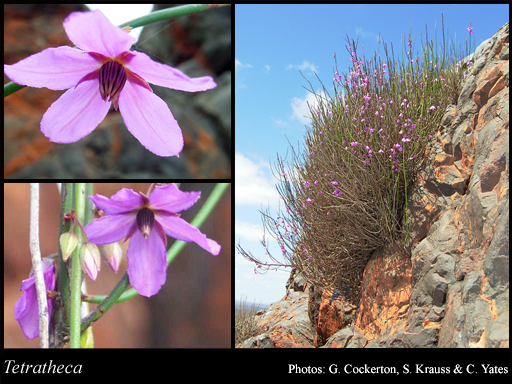- Reference
- Spec.Bot.New Holland 5, tab. 2 (1793)
- Name Status
- Current

Scientific Description
Common name. Pinkeyes. Family Tremandraceae.
Habit and leaf form. Small shrubs, or herbs (slender subshrubs, or subherbaceous but basically woody). ‘Normal’ plants, or switch-plants; sometimes with the principal photosynthesizing function transferred to stems. Leaves well developed, or much reduced. Perennial; plants with neither basal nor terminal concentrations of leaves; to 0.1–1.5 m high. Mesophytic, or xerophytic. Leaves minute to small; alternate, or opposite, or whorled, or alternate to whorled; when alternate, spiral; when whorled, 3–6 per whorl; not decurrent on the stems; with blades, or bladeless (when reduced to scales?); ‘herbaceous’, or leathery, or membranous; imbricate, or not imbricate; petiolate to sessile; non-sheathing; simple; epulvinate. Leaf blades dorsiventral; entire; flat, or rolled (often ericoid); linear to ovate, or elliptic, or orbicular; one-veined, or pinnately veined; cross-venulate, or without cross-venules; attenuate at the base, or cuneate at the base, or rounded at the base. Mature leaf blades adaxially glabrous, or pubescent (and often tuberculate); abaxially glabrous, or pubescent (and sometimes tuberculate). Leaves without stipules, or with stipules (if so interpreted). Stipules represented by glands. Leaf blade margins entire, or dentate; flat, or revolute. Leaves without a persistent basal meristem. Leaf anatomy. Hairs present, or absent; glandular hairs present, or absent; complex hairs present, or absent. Branched hairs absent. Stem anatomy. Nodes unilacunar. Secondary thickening developing from a conventional cambial ring.
Reproductive type, pollination. Fertile flowers hermaphrodite. Unisexual flowers absent. Plants hermaphrodite. Floral nectaries absent.
Inflorescence and flower features. Flowers usually solitary (axillary, slender-pedunculate), or aggregated in ‘inflorescences’ (occasionally); axillary; occasionally 2–4 per axil. Inflorescences when flowers grouped, axillary. Flowers pedicellate; one or more bracteate, or ebracteate; small; regular (with a pronounced receptacle); 4 merous, or 5 merous; cyclic; tetracyclic (interpreting the stamens as one whorl). Free hypanthium absent. Hypogynous disk absent. Perianth with distinct calyx and corolla; 8, or 10; 2 -whorled; isomerous. Calyx present; 4–5; 1 -whorled; polysepalous; erect; hairy, or glabrous; valvate (secured by hairs in the bud); exceeded by the corolla; regular; green, or red, or pink, or purple; not persistent; non-accrescent; with the median member posterior. Sepals ovate. Corolla present; 4, or 5; 1 -whorled; polypetalous; induplicate valvate; regular; glabrous abaxially; glabrous adaxially; plain, or with contrasting markings; white (uncommonly), or pink, or purple; persistent (rarely), or deciduous; non-accrescent. Petals ovate, or obovate (usually linguiform); sessile; not hooded; not navicular. Corolla members entire (blunt). Androecial members definite in number. Androecium 8, or 10. Androecial members ambiguously branched, or unbranched. Androecial sequence not determinable. Androecial members free of the perianth; all equal; free of one another, or coherent (in pairs); 4 - adelphous, or 5 - adelphous (interpreting the pairs as ‘bundles’). The androecial groups opposite the petals. Androecial members 1 -whorled (seemingly, though twice the corolla in number). Androecium exclusively of fertile stamens. Stamens 8, or 10; remaining included; all more or less similar in shape; diplostemonous; alternisepalous (in antepetalous pairs); all opposite the corolla members; erect in bud; filantherous (with short filaments). Filaments not appendiculate; glabrous; strap-shaped, or flattened, broadened above. Anthers all alike; basifixed; non-versatile; dehiscing via pores (each anther by a single apical pore, this usually terminating a short to long tube); four locular; tetrasporangiate; appendaged, or unappendaged. The anther appendages when present, apical (in the form of the pore-bearing tube). Gynoecium 2 carpelled. The pistil 2 celled. Carpels reduced in number relative to the perianth. Gynoecium syncarpous; eu-syncarpous; superior. Ovary plurilocular; 2 locular. Gynoecium median. Ovary sessile. Gynoecium stylate. Styles 1; attenuate from the ovary; apical; not becoming exserted; persistent; hairless. Styles straight in bud. Stigmas 1; 1 - lobed (entire); punctiform. Placentation axile, or apical. Ovules 1–2(–5) per locule; pendulous; epitropous; with ventral raphe; arillate (usually), or non-arillate; anatropous.
Fruit and seed features. Fruit sessile; falling from the plant before the next growing season; non-fleshy; dehiscent; a capsule. Capsules loculicidal, or septicidal and loculicidal. Fruit 2 celled; 2 locular. Dispersal unit the seed. Fruit 1–10 seeded. Seeds 1–2(–5) per locule. Seeds endospermic; not mucous; arillate, or non-arillate; conspicuously hairy; winged (via a twisted apical appendage), or wingless. Seed wings not encircling body. Embryo well differentiated. Cotyledons 2. Embryo straight.
Geography, cytology, number of species. Native of Australia. Endemic to Australia. Australian states and territories: Western Australia, South Australia, Queensland, New South Wales, Victoria, Australian Capital Territory, and Tasmania. Eremaean Botanical Province and South-West Botanical Province. Mainly in mesic southern Australia. A genus of 42 species.
Etymology. From the Greek for "four" and "box"; refers to the four cells of the anthers.